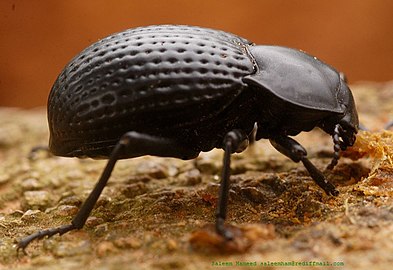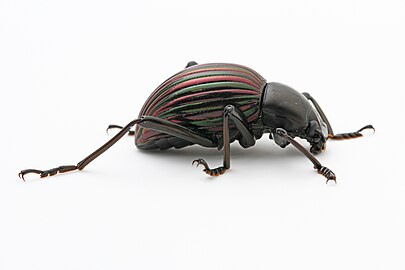Darkling beetle
| Darkling beetle Temporal range:
| |
|---|---|

| |
| Alphitobius sp. (Tenebrioninae: Alphitobiini) Scale bar (top right) is 2 mm | |
| Scientific classification | |
| Domain: | Eukaryota |
| Kingdom: | Animalia |
| Phylum: | Arthropoda |
| Class: | Insecta |
| Order: | Coleoptera |
| Suborder: | Polyphaga |
| Infraorder: | Cucujiformia |
| Superfamily: | Tenebrionoidea |
| Family: | Tenebrionidae Latreille, 1802 |
| Subfamilies | |
|
See text | |
| Synonyms | |
|
Alleculidae | |
Darkling beetle is the common name for members of the beetle family Tenebrionidae, comprising over 20,000 species in a cosmopolitan distribution.
Taxonomy
Tenebrio is the Latin generic name that Carl Linnaeus assigned to some flour beetles in his 10th edition of Systema Naturae 1758-59.[1] The name means "lover of darkness";[2] the English language term 'darkling' means "characterised by darkness or obscurity";[3] see also English 'tenebrous', figuratively "obscure, gloomy."[4]
Many Tenebrionidae species inhabit dark places; in
The family covers a varied range of forms, such that classification presents great difficulties. These eleven subfamilies were listed in the 2021 review by Bouchard, Bousquet, et al., updating a similar catalog from 2005.[5][6]
- Alleculinae Laporte, 1840
- Blaptinae Leach, 1815
- Diaperinae Latreille, 1802
- Kuhitangiinae G.S. Medvedev, 1962
- Lagriinae Latreille, 1825
- NilioninaeOken, 1843
- Phrenapatinae Solier, 1834
- Pimeliinae Latreille, 1802
- Stenochiinae Kirby, 1837
- Tenebrioninae Latreille, 1802
- Zolodininae Watt, 1975
Ongoing phylogenetic studies are showing that some taxonomic changes are needed. For instance the tribal classification of tribe Pedinini has recently been altered.[7]
The misspelling "Terebrionidae" occurs frequently enough to be easily overlooked.[8][9] The error appears to have no particular significance, but to be the product of misreadings, mis-scans and mis-typings.

The oldest known member of the family is Jurallecula from the Late Jurassic Karabastau Formation of Kazakhstan, assigned to the subfamily Alleculinae.
Characteristics
The Tenebrionidae may be identified by a combination of features, including:
- Their eleven-segmented antennae that may be filiform, moniliform or weakly clubbed
- First abdominal coxae
- Eyes notched by a frontal ridge
- Four segments in the hind pair of tarsi and five in the fore and mid-legs (5-5-4), with simple claws
Biology and ecology
Tenebrionid beetles occupy

The
Humans spread some species such that they have become cosmopolitan, such as
Notable types
The
- .
- Tribolium castaneum is a laboratory animal useful as a model organism, especially in studies of intragenomic conflict and population ecology.
- superworm, is valued as a feed for captive reptiles; it contains less chitinthan Tenebrio molitor.
- Alphitobius diaperinus, lesser mealworm[15]
- Many tenebrionids are pests of Tribolium destructor, and Gnathocerus cornutus.
- In southwestern North America, species of the genus pinacate beetles" or "desert stink beetles".
- Several genera, such as Stenocara and Onymacris, are of interest in ecological studies of arid conditions and their associated adaptations.
- Ulomoides dermestoides, known as "chinese weevil", "peanut beetle", "cancer beetle", or "asthma beetle", is eaten in Argentina where it is thought to be a treatment for cancer, asthma, and other illnesses.
Gallery
-
Diaperis boleti under bark of oak.
-
Platynotus excavatus, India
-
Stenocara dentata in southern Africa
-
Pie dish beetle, Helea sp. in Australia
-
Hegemona sp. (De Laporte, 1840) from Belize
-
Neomida bicornis, male
-
Neomida bicornis, female
-
Meracantha contracta, USA
References
- ^ Linnaeus, Carl (1759). "Caroli Linnæi ... Animalium specierum in classes, ordines, genera, species, methodica dispositio ." (in Latin). Leiden: Theodor Haak. p. 134.
- ISBN 0398009163.
- ISBN 0198612710.
- ISBN 978-0-19-861116-5.
- ^
Bouchard, Patrice; Bousquet, Yves; Aalbu, Rolf L.; Alonso-Zarazaga, Miguel A.; et al. (2021). "Review of genus-group names in the family Tenebrionidae (Insecta, Coleoptera)". ZooKeys (1050): 1–633. PMID 34385881.
- ^ Bouchard, Patrice; Lawrence, John F.; Davies, Anthony E.; Newton, Alfred F. (2005) "Synoptic Classification of the World Tenebrionidae (Insecta: Coleoptera) with a Review of Family-Group Names". Annales Zoologici (Warszawa), 55(4): 499–530.
- .
- ISBN 978-0412498008.
- ^ "Egyptian Beetle (Blaps polychresta) - by Graeme Ruck - JungleDragon". www.jungledragon.com. Retrieved 2023-02-02.
- ^ "Species Bolitotherus cornutus – Forked Fungus Beetle".
- YouTube
- ^ a b "Family Tenebrionidae - Darkling Beetles". bugguide.net. Retrieved 2023-02-02.
- ^ "Bolitotherus cornutus". Archived from the original on 2016-03-04. Retrieved 2015-08-14.
- ^ "Desert beetles inspire aircraft design that doesn't freeze". ZME Science. 2016-01-25. Retrieved 2016-01-27.
- ^ Alphitobius diaperinus, lesser mealworm. University of Florida IFAS










